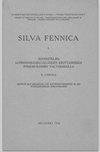Allometric models for estimating aboveground biomass and carbon stock for Diospyros mespiliformis in West Africa
IF 1.7
3区 农林科学
Q2 FORESTRY
引用次数: 4
Abstract
Accurate estimates of aboveground biomass (AGB) strongly depend on the suitability and precision of allometric models. Diospyros mespiliformis Hochst. ex A. DC. is a key component of most sub-Sahara agroforestry systems and, one of the most economically important trees in Africa. Despite its importance, very few scientific information exists regarding its biomass and carbon storage potential. In this study direct method was used to develop site-specific biomass models for D. mespiliformis tree components in Burkina Faso. Allometric models were developed for stem, branch and leaf biomass using data from 39 tree harvested in Sudanian savannas of Burkina Faso. Diameter at breast height (DBH), tree height, crown diameter (CD) and basal diameter (D20) were regressed on biomass component using non-linear models with DBH alone, and DBH in combination with height and/or CD as predictor variables. Carbon content was estimated for each tree component using the ash method. Allometric models differed between the experimental sites, except for branch biomass models. Site-specific models developed in this study exhibited good model fit and performance, with explained variance of 81–98%. Using models developed from other areas would have underestimated or overestimated biomass by between –72% and +98%. Carbon content in aboveground components of D. mespiliformis in Tiogo, Boulon and Tapoa-Boopo was 55.40% ± 1.50, 55.52% ± 1.06 and 55.63% ± 1.00, respectively, and did not vary significantly (P-value = 0.909). Site-specific models developed in this study are useful tool for estimating carbon stocks and can be used to accurately estimate tree components biomass in vegetation growing under similar conditions.估算西非messpiliformis地上生物量和碳储量的异速生长模型
准确估计地上生物量(AGB)在很大程度上取决于异速生长模型的适用性和精度。半刺棘球蛾。解析:选a。是撒哈拉以南大多数农林业系统的关键组成部分,也是非洲最具经济价值的树木之一。尽管它很重要,但关于其生物量和碳储存潜力的科学信息很少。在本研究中,采用直接方法建立了布基纳法索中螺线虫树组分的特定地点生物量模型。利用来自布基纳法索苏丹稀树草原的39棵树的数据,开发了茎、枝和叶生物量的异速生长模型。采用以胸径单独、胸径与高度和/或胸径联合为预测变量的非线性模型,对胸径、树高、冠径和基径进行回归。利用灰分法估算了树木各组分的碳含量。除枝条生物量模型外,各试验点间异速生长模型存在差异。本研究建立的特定地点模型具有良好的模型拟合和性能,解释方差为81-98%。使用从其他地区开发的模型将低估或高估生物量在-72%至+98%之间。Tiogo、Boulon和Tapoa-Boopo 3个地区中刺状芽孢菊地上组分碳含量分别为55.40%±1.50、55.52%±1.06和55.63%±1.00,差异不显著(p值= 0.909)。本研究建立的立地模型是估算碳储量的有效工具,可用于准确估算相似条件下植被的树组分生物量。
本文章由计算机程序翻译,如有差异,请以英文原文为准。
求助全文
约1分钟内获得全文
求助全文
来源期刊

Silva Fennica
农林科学-林学
CiteScore
3.50
自引率
11.10%
发文量
21
审稿时长
3 months
期刊介绍:
Silva Fennica publishes significant new knowledge on forest sciences. The scope covers research on forestry and forest ecosystems. Silva Fennica aims to increase understanding on forest ecosystems, and sustainable use and conservation of forest resources. Use of forest resources includes all aspects of forestry containing biomass-based and non-timber products, economic and social factors etc.
 求助内容:
求助内容: 应助结果提醒方式:
应助结果提醒方式:


